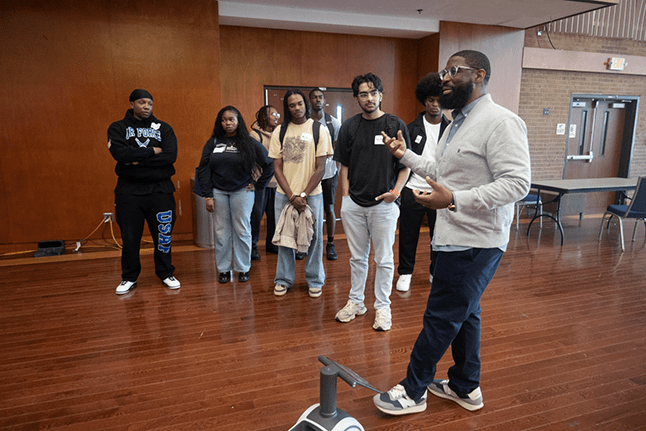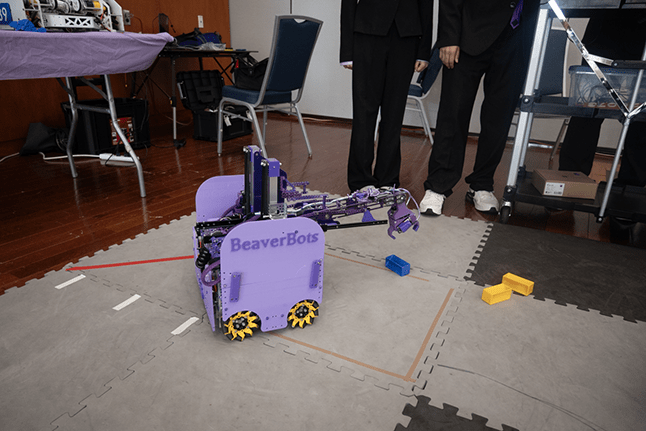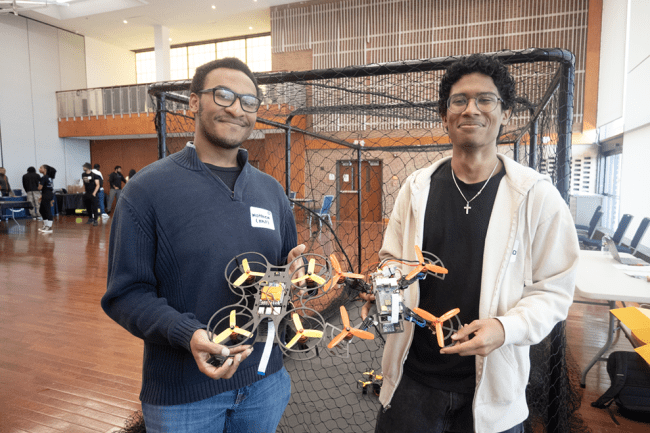Last week in Blackburn Center, Howard University welcomed middle school, high school, and college students to explore the rapidly expanding world of robotics over the course of its second Robotics and AI Outreach Event. Teams of high school students showcased robots they built, while representatives from partnering Amazon Fulfillment Technologies, FIRST Robotics, the U.S. Navy and U.S. Army Research Laboratories, and Viriginia Tech gave presentations on their latest technologies, as well as ways to get involved in high-tech research.
Across Thursday and Friday, Howard students and middle and high schoolers from across the DMV region heard from university researchers creating stories with generative AI and learned how they can get involved in STEM outreach from the Howard University Robotics Organization (HURO) and FIRST Robotics. They also viewed demonstrations of military unmanned ground vehicles and the Amazon Astro household robot. The biggest draw, however, was the robotics showcase in the East Ballroom.

Over both days, middle and high school teams from across the DMV presented their robots as part of the FIRST Tech Challenge (FTC) and FIRST Robotics Competition, during which they were tasked with designing a robot within six weeks. The program is intensive and gives students a taste of a real-world engineering career, as the students not only design and build their entries, but also engage in outreach events and raise their own funding each year.
“It’s incredible,” said Shelley Stoddard, vice president of FIRST Chesapeake. “I liken our teams to entrepreneurial startups. Each year they need to think about who they’re recruiting, how they’re recruiting; what they’re going to do for fundraising. If they want to have a brand, they create that, they manage that. We are highly encouraging of outreach because we don’t want it to be insular to just their schools or their classrooms.”
Reaching the Next Generation of Engineers
This entrepreneurial spirit carries across the teams, such as the Ashburn, Virginia-based BeaverBots, who showed up in matching professional attire to stand out to potential recruits and investors as they presented three separate robots they’ve designed over the years — the Stubby V2, Dam Driver V1, and DemoBot — all built for lifting objects. Beyond already being skilled engineers and coders in their own right, the team has a heavy focus on getting younger children into robotics, even organizing their own events.

“One of the biggest things about our outreach is showing up to scrimmages and showing people we actually care about robotics and want to help kids join robotics,” said team member and high school junior Savni (last name withheld). “So, for example we’ve started a team in California, we’ve mentored [in] First Lego League, and we’ve hosted multiple scrimmages with FTC teams.”
“We also did a presentation in our local Troop 58 in Ashburn, where we showed our robot and told kids how they can get involved with FIRST,” added team vice-captain Aryan. “Along with that, a major part of our fundraising is sponsorship and matching grants. We’ve received matching grants from CVS, FabWorks, and ICF.”
This desire to pay it forward and get more people involved in engineering wasn’t limited to the teams. Members of the student-run HURO were also present, putting on a drone demo and giving lectures advocating for more young Black intellectuals to get into science and engineering.
“Right now, we’re doing a demo of one of our drones from the drone academy,” explained senior electrical engineering major David Toler II. “It’s a program we’ve put on since 2024 as a way to enrich the community around us and educate the Black community in STEM. We not only provide free drones to high schools, but we also work hands-on with them in very one-on-one mentor styles to give them knowledge to build on themselves and understand exactly how it works, why it works, and what components are necessary.”
Building A Strong Support Network
HURO has been involved with the event from the beginning. Event organizer and Howard professor Harry Keeling, Ph.D., credits the drone program for helping the university’s AI and robotics outreach take flight.
“It started with the drone academy, then that expanded through Dr. Todd Shurn’s work through the Sloan Foundation in the area of gaming,” explained Keeling. “Then gaming brought us to AI, and we got more money from Amazon and finally said ‘we need to do more outreach.’”
Since 2024, Keeling has been working to bring more young people into engineering and AI research, relying on HURO, other local universities and high schools, industry partners like Amazon, and the Department of Defense, to build a strong network dedicated to local STEM outreach. Like with FIRST Robotics, a large part of his motivation with these growing partnerships is to prepare students for successful jobs in the industry.
“We tell our students that in this field, networking is how you accomplish career growth,” he said. “None of us knows everything about what we do, but we can have a network where we can reach out to people who know more than we do. And the stronger our network is, the more we are able to solve problems in our own personal and professional lives.”
At next year’s event, Keeling plans to step back and allow HURO to take over more of the organizing and outreach, further bringing the next generation into leadership positions within the field. Meanwhile, he is working with other faculty members across the university to bring AI to the curriculum, further demystifying the technology and ensuring Howard students are prepared for the future.
For Keeling, outreach events like this are vital to ensuring that young people feel confident in entering robotics, rather than intimidated.
“One thing I realized is young people gravitate to what they see,” he said. “If they can’t see it, they can’t conceive it. These high schoolers[and] middle schoolers are getting a chance to rub elbows with a lot of professionals [and] understand what a roboticist ultimately might be doing in life.”
He hopes that his work eventually makes children see a future in tech as just as possible as any other field they see on TV.
“I was talking with my daughters, and I asked them at dinner ‘what do you want to be when you grow up?’” Keeling said. “And my youngest one said astronauts, and an artist, and a cook. Now hopefully one day, one of those 275 students that were listening to my presentation will answer the question with ‘I want to be an AI expert. I want to be a roboticist.’ Because they’ve come here, they’ve seen and heard what they can do.”





